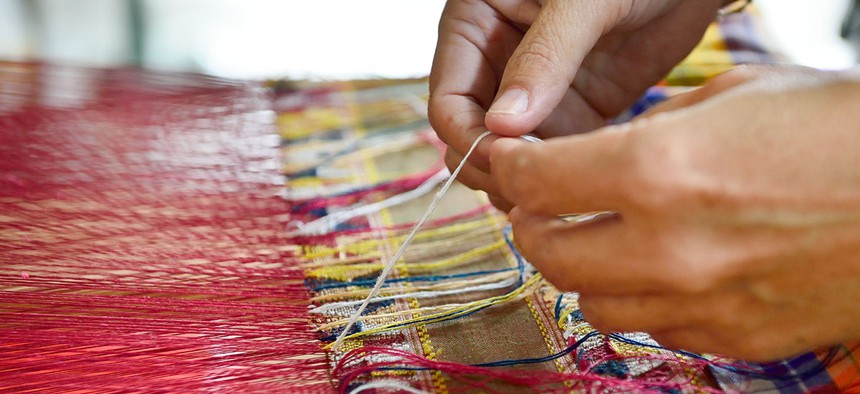Scientists Are Weaving Futuristic Artificial Muscles Using Traditional Textile Techniques

Thanipat Peeramatukorn/Shutterstock.com
These fake muscles move like human muscles and can be worn under clothing.
Fabric is miraculous. Cloth bends and stretches, yet retains shape and can handle wear and tear. This flexibility and durability is due to two things—how threads are knit together, and how they’re then woven into material. These two processes form a complex interlay of individual fibers that make a strong unified whole.
Like textiles, human muscles are made of naturally knit fibers that can expand and contract, and even heal themselves. This inspired Swedish scientists from Linköping University, and smart fabric designers from the Swedish School of Textiles, to experiment with using traditional knitting and weaving techniques to create futuristic artificial muscles. In a study published in Science Advances on Jan. 25, the researchers explain that these fake muscles move like human muscles and can be worn under clothing, like a sleeve, say.
Traditionally, artificial muscles used in robotics and medicine are made with relatively rigid materials, like plastics. Often, these artificial parts move with motor power, and are extremely sensitive to strains and ruptures. Unlike human muscles, they don’t heal. Researchers have been working on improving this technology, for example, using mice stem cells to growing muscles for people.
But as the study’s authors write, “A need exists for artificial muscles that are silent, soft, and compliant, with performance characteristics similar to those of skeletal muscle.” Their experiment shows that “by combining one of humankind’s oldest technologies, textile processing, with electroactive polymers, we demonstrate here the feasibility of wearable, soft artificial muscles made by weaving and knitting, with tunable force and strain.” The new fake muscles mimic organic structure in their complexity and flexibility, which makes them more durable than the materials currently being used, the researchers say.
Their approach to creating the fabric is fascinating for its blend of old and new technologies. The method is similar to one employed by scientists experimenting with textiles to power mobile devices. That method involved coating the fabric in tiny solar panels to harness the sun’s energy.
To create these “muscles,” the team first knit together threads, like the strong synthetic fibre Lyocell, in old-fashioned, complex patterns that have proven particularly strong and stood the test of time. Next, they wove those threads using methods historically considered exceptionally effective for textile strength and flexibility. Finally, they dyed the fabrics. The result is a totally futuristic material, mostly due to the dye. Instead of soaking the cloth in a color, the dye was a wash of electroactive polymers that power the material and make it, well, electronic.
Given the complexity of the material, and the need for an even coating, this “dyeing” was a very involved process, much more complicated than throwing some white t-shirts in a pot of boiling water and drugstore dye. The fabric was coated in the polymers using a two-step chemical-electrochemical synthesis. First, a chemically synthesized “seed layer” was deposited on the fabric to form a highly electrically conductive surface. To uniformly coat the seed layer, they used a technique called vapor-phase polymerization. Then, researchers tested the tensile strength and durability of the “muscles”, experimenting with different combinations of thread materials.
The team concludes that the natural movement of this fabric makes technological textile a more organic material for medicinal and robotic muscle construction. But their muscle sleeves aren’t about to be mass produced anytime soon. They are still “investigating in more detail the effect of textile architecture on performance.”
The scientists are still tinkering. But perhaps artificial muscles that help humans to move will soon move more like humans, acting likehigh tech mimics, with the knit and fit of an old favorite sweater.


